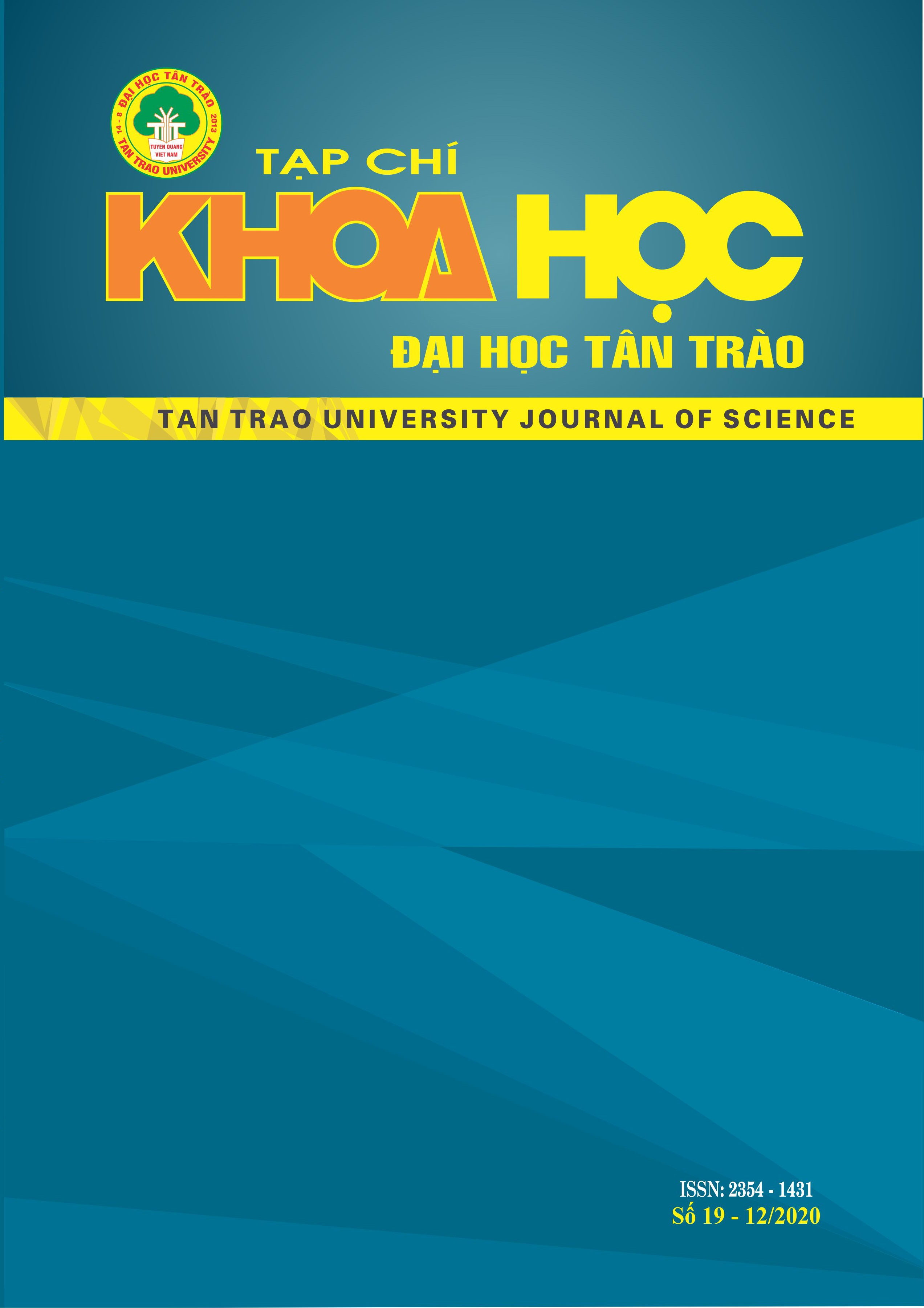SỰ PHỤ THUỘC VÀO NHIỆT ĐỘ CỦA DAO ĐỘNG EXAFS PHÍ ĐIỀU HÒA CỦA TINH THỂ SILIC
DOI:
https://doi.org/10.51453/2354-1431/2020/435Từ khóa:
năng lượng gió ngoà i khÆ¡i, phát triển kinh tế biển, biến đổi khà háºu, phân tÃch SWOT, Việt Nam.Tóm tắt
Trong công việc này, dao động của phổ cấu trúc tinh tế mở rộng (EXAFS) phi điều hòa của tinh thể silic đã được biểu diễn qua các số hạng của hệ số Debye-Waller bằng phương pháp khai triển cumulant đến bậc bốn. Bốn EXAFS cumulant đầu tiên đã được tính toán dựa trên mô hình Einstein tương quan phi điều hòa (ACE) cổ điển và qui trình phân tích phù hợp, trong đó các tham số nhiệt động được rút ra từ hàm thế hiệu dụng phi điều hòa thu được bằng cách tíếp cận các đóng góp lân cận của lớp nguyên tử đầu tiên. Việc phân tích sự phụ thuộc vào nhiệt độ của dao động EXAFS được thực hiện thông qua việc đánh giá ảnh hưởng của các cumulant vào sự giảm biên độ và sự dịch pha. Các kết quả tính số được tìm thấy trùng hợp tốt với các kết quả thu được bằng mô hình ACE lượng tử và thực nghiệm ở các nhiệt độ khác nhau. Các kết quả thu được là rất hữu ích đối trong việc phân tích các dữ liệu EXAFS thực nghiệm của c-Si.
Tải xuống
Tài liệu tham khảo
[1] F.W. Lytle, D.E. Sayers, E.A. Stern, Extended x-ray-absorption fine-structure technique. II. Experimental practice and selected results, Phys. Rev. B 11 (1975) 4825-4835.
[2] G. Beni and P.M. Platzman, Temperature and polarization dependence of extended x-ray absorption fine-structure spectra, Phys. Rev. B 14 (4) (1976) 1514-1518.
[3] J.J. Rehr and R.C. Albers, Theoretical approaches to x-ray absorption fine structure, Rev. Mod. Phys. 72 (3) (2000) 621-654.
[4] G. Bunker, Applications of the ratio method of EXAFS analysis to disordered systems, Nucl. Instrum. Methods 207 (1983) 437-444.
[5] N.V. Hung, T.S. Tien, N.B. Duc, D.Q. Vuong, High-order expanded XAFS Debye-Waller factors of HCP crystals based on classical anharmonic correlated Einstein model, Mod. Phys. Lett. B 28 (21) (2014) 1450174.
[6] N.V. Hung and J.J. Rehr, Anharmonic correlated Einstein-model Debye-Waller factors, Phys. Rev. B 56 (1) (1997) 43-46.
[7] E.A. Stern, P. Livins, Z. Zhang, Thermal vibration and melting from a local perspective, Phys. Rev. B 43 (11) (1991) 8850-8860.
[8] T.S. Tien, N.V. Hung, N.T. Tuan, N.V. Nam, N.Q. An, N.T.M. Thuy, V.T.K. Lien, N.V. Nghia, High-order EXAFS cumulants of diamond crystals based on a classical anharmonic correlated Einstein model, J. Phys. Chem. Solids 134 (2019) 307-312.
[9] T.S Tien, Advances in studies of the temperature dependence of the EXAFS amplitude and phase of FCC crystals, J. Phys. D: Appl. Phys. 53 (2020) 315303.
[10] T. Yokoyama, K. Kobayashi, T. Ohta, A. Ugawa, Anharmonic interatomic potentials of diatomic and linear triatomic molecules studied by extended x-ray-absorption fine structure, Phys. Rev. B 53 (10) (1996) 6111-6122.
[11] L.A. Girifalco and V.G. Weizer, Application of the Morse potential function to cubic metals, Phys. Rev. 114 (3) (1959) 687-690.
[12] V.V. Hung and H.K. Hieu, Study the Temperature Dependence of EXAFS Cumulants of Si and Ge by the Anharmonic Correlated Einstein Model, Commun. Phys. 21 (1) (2011) 25-34.
[13] M. Benfatto, C.R. Natoli, A. Filipponi, Thermal and structural damping of the multiple-scattering contributions to the x-ray-absorption coefficient, Phys. Rev. B 40 (14) (1989), 9626-9635.
[14] R.A.Swalin, Theoretical calculations of the enthalpies and entropies of diffusion and vacancy formation in semiconductors, J. Phys. Chem. Solids 18 (4) (1961) 290-296.
[15] N.V. Hung, C.S. Thang, N.B. Duc, D.Q. Vuong, T.S. Tien, Temperature dependence of theoretical and experimental Debye-Waller factors, thermal expansion and XAFS of metallic Zinc, Physica B 521 (2017)198-203.
Tải xuống
Đã Xuất bản
Cách trích dẫn
Số
Chuyên mục
Giấy phép

Tác phẩm này được cấp phép theo Giấy phép Quốc tế Creative Commons Attribution-ShareAlike 4.0 .
Bài báo được xuất bản ở Tạp chí Khoa học Đại học Tân Trào được cấp phép theo giấy phép Ghi công - Chia sẻ tương tự 4.0 Quốc tế (CC BY-SA). Theo đó, các tác giả khác có thể sao chép, chuyển đổi hay phân phối lại các bài báo này với mục đích hợp pháp trên mọi phương tiện, với điều kiện họ trích dẫn tác giả, Tạp chí Khoa học Đại học Tân Trào và đường link đến bản quyền; nêu rõ các thay đổi đã thực hiện và các nghiên cứu đăng lại được tiến hành theo cùng một bản quyền.
Bản quyền bài báo thuộc về các tác giả, không hạn chế số lượng. Tạp chí Khoa học Tân Trào được cấp giấy phép không độc quyền để xuất bản bài báo với tư cách nhà xuất bản nguồn, kèm theo quyền thương mại để in các bài báo cung cấp cho các thư viện và cá nhân.
Mặc dù các điều khoản của giấy phép CC BY-SA không dành cho các tác giả (với tư cách là người giữ bản quyền của bài báo, họ không bị hạn chế về quyền hạn), khi gửi bài tới Tạp chí Khoa học Đại học Tân Trào, tác giả cần đáp ứng quyền của độc giả, và cần cấp quyền cho bên thứ 3 sử dụng bài báo của họ trong phạm vi của giấy phép.






